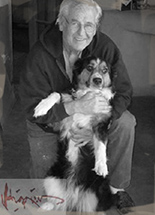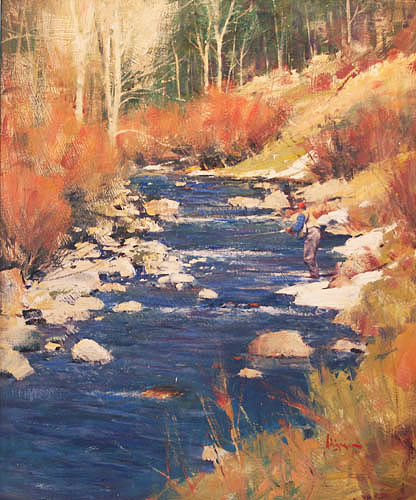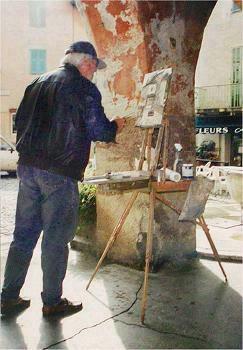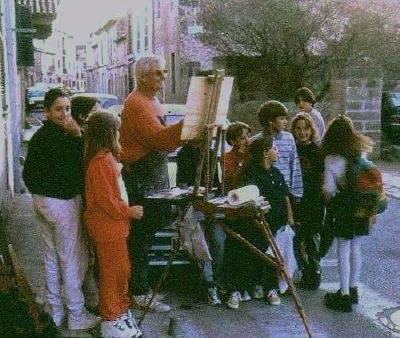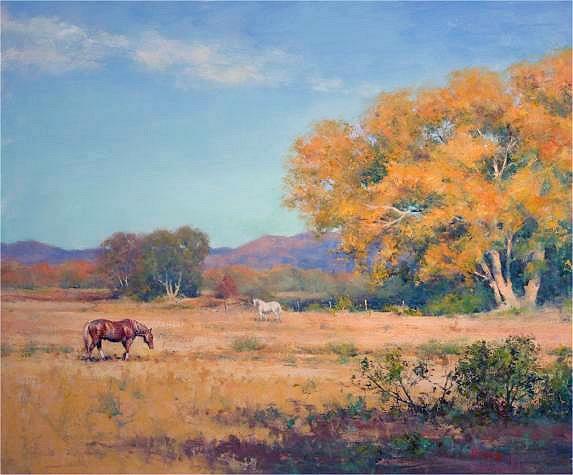Becoming a Landscape Painter
After leaving art school, the student faces many possible directions. I once heard Mr. Reilly say that, “Students get out of school and ask the Cop on the corner how they should paint.” He had seen many promising students who seemed to have, in his words, “The will to fail.”
The best methods of providing for advancement are drawing and painting frequently, devouring books by and about master artists and taking the ‘advice’ found by studying fine paintings. These were the practices I adopted.
Painting landscapes was something I loved to do with my spare time, not yet a career choice but the most likely direction. From my art school training I knew how to draw and paint the figure, the most demanding skills and a solid a foundation for learning landscape. Mr. Reilly had provided many ideas but it was clear that a great deal of further development was necessary in order to begin a career as a landscape painter.
One of the first challenges was to learn how to use an open palette. Neutralizing with complements and arranging the paint on my palette without mixing strings of values as we did in Mr. Reilly’s class. My years as a professional actor provided ample free time for the discovery and application of painting ideas.
A demonstration on location in Abiquiu (Pronounced Abba Cue), New Mexico for Karen Halbert and Judy Howells, October, 2014. My furry friend Alfie was in attendance.
There are some random color additions on the right of my palette not part of my basic colors which are, white, cad yellow light, cad yellow medium, yellow ochre, cad red light, phthalo blue, ultramarine blue, alizarin crimson and Viridian.
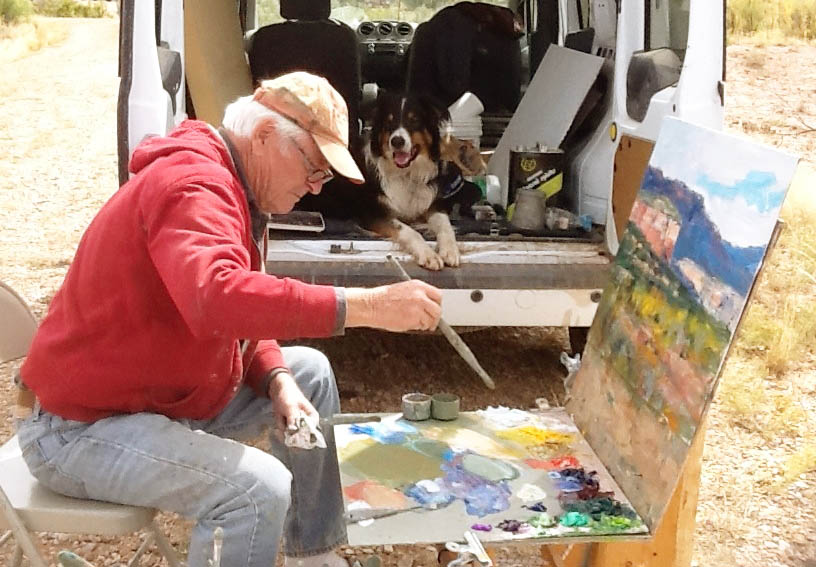
Painting Techniques
As my work matured, I eventually developed techniques. Two for more detailed work and one for plein air (examples below). Detailed work has to do with more accurate explanations of the elements within the painting. For plein air painting the emphasis is on color, directional brushwork, palette knife and the use of analogous, complementary and near complementary color. Detail is suggested. The majority of my work is plein air.
A technique is the characteristic appearance of an artist’s paintings which identifies them as the work of that artist.
Technique can be forced by the imposition of tricky paint applications but this approach has the unfortunate consequence of producing only short term attraction-power and for the viewer to look at the painting rather than into it. Then too, the adoption of the technique of another artist or that of a teacher is to be avoided due to the revelation of an undesirable lack of originality. The work of an artist should exhibit individuality but not call undue attention to the methods employed. The way to arrive at a technique is to have it evolve naturally as the artist develops.
Artists learn largely by imitation and my work and techniques have been influenced by studying and sometimes copying the paintings of artists I admire. Artists such as, Frederick Waugh, Edgar Degas, Fedor Zakharov, Bernie Fuchs and Anders Zorn, to name but a few, but in my current work these influences have been subsumed and my techniques are my own. I think it was Harley Brown who said that, ‘To paint like one artist is a kind of plagiarism but to paint like many artists is research.’
creative process
As my work matured, I eventually developed techniques. Two for more detailed work and one for plein air (examples below). Detailed work has to do with more accurate explanations of the elements within the painting. For plein air painting the emphasis is on color, directional brushwork, palette knife and the use of analogous, complementary and near complementary color. Detail is suggested. The majority of my work is plein air.
A technique is the characteristic appearance of an artist’s paintings which identifies them as the work of that artist.
The act of putting these principles into practice brings me to the creative process which has to do with the bringing of something of value into existence. Fundamental to the creative process is an excellent technical performance, a full understanding and execution of the tenets of realism. It must be understood that painting is not an imitation of facts but a summarizing of essentials, to paraphrase Whistler, ‘Nature is always wrong.’ She offers too much. So what I exclude in my work is just as important as what I include, invent, exaggerate, shift in position or suppress.
Because I’m primarily an outdoor landscape painter, discovering fresh and compelling subject matter is an integral part of the creative process. This has to do with emotional response and taste and remains individual and largely a mystery. It can be said, however, that I must be able to visualize a painting in my mind’s eye or I move on.
For me, spontaneity is essential to creative process. Especially in the beginning of a painting, I paint positively and rapidly, trusting that I will have a sufficiency of solutions to solve the problems that arise. Toward the end however I adopt a slower, and yes, tighter procedure.
Whatever the given amount of creativity one possesses, it can be expanded. The key is to establish a life long self-imposed internal discipline dedicated to excellence. Some of the methods I’ve devised to help the growth process along are as follows; to study the methods of an artist I admire and to make some of them my own, to follow the suggestions in a book by a respected artist, to investigate; high key painting, all weather conditions, interiors, night painting, dominant color, impressionist color theory, still life, portraits, to work with a limited palette or from memory. I have studied marines by Frederick Waugh, stared at and sketched the ocean in order to become thoroughly acquainted with waves in their various stages and to gain an understanding of the meeting of land and sea. Lengthy studies of elusive subjects have been profitable. These and many other areas of inquiry are worked on separately from the paintings that find their way into the galleries and shows. I consider these parallel track studies to be essential to the creative process, ‘Art is not a destination, but a means of travel’.
The words “Creative process” are generally used to describe the creation of an individual work of art, but I would suggest that the truly creative process is how the life of an artist is self-created. If the work flowing from that life reveals an ever increasing level of accomplishment then a more fundamental, life enhancing, creative process is in operation.
There have been times, however, when I seemed to have hit a brick wall in terms of growth, when the creative process seems to be stagnating. During these times I don’t paint in the field, sometimes for weeks at a time, but seek ways to shake things up, working in my studio. I experiment by finding new or reorganized approaches. Often experiments fail, but as Henry Ford once said, “Failure is an opportunity to begin again with more information.” So far, I’ve come out of these periods with renewed enthusiasm.
PAINTING PROCEDUERE
To paint on location means to paint a moment. After the first thirty minutes or so due primarily to the movement of the sun, I’m seeing misleading visual information. The moment is gone and I’m proceeding largely in conformity to the original statements. I had to learn as a plein air painter to anticipate that which would change most radically and make those statements early on.
For “Painting at Smith Cove” above, I first painted in my mind making such decisions as, focus, (blue boat), composition (arrangement of masses and horizon line), general value scheme, edges, relative sizes, and where I would reduce or heighten the intensity of color. Notice how the blue boat stands out as a result of the color choices. I then began to paint, first drawing with a brush (sometimes a pencil) and a neutral dark in a general way. Then, using vigorous brushwork, washes and at times fairly heavy paint, much of surface was covered. The darkest dark’s and the lightest lights were established in order to make comparisons within the extremes.
The idea at this and every stage is to be carefully careless. It is far better to make a ‘mistake’ and trim than to push the paint around and have it lose its vitality. Another choice for misstatements is to scrape and restate. When trimming, I take the trouble to mix and match so as always to work with a loaded brush keeping in mind the ensemble and not only the particular. Now and then a palette knife was used especially to indicate the jumble of objects on the wharf or for sharp edges. I softened the edges in the background tree line as a foil for the clarity of the various elements in the middle and near distance. The dock pilings and foreground rock arrangement are readily descriptive and I painted them keeping in mind the principle of unequal measures. Variety of color for the rocks and elsewhere was achieved by not over-mixing the paint on the palette. The thinking for the painting of the rocks and elsewhere is; top planes light, front planes medium and under planes dark. The danger is to paint piecemeal and extend the value range beyond the original mass decisions.
If the whites in a painting are surrounded with warms they become cool and with cools, warm, so I add a touch of yellow to white in sunlight. For this, and much more, I would refer you to M. E. Chevreul’s book, The Principles of Harmony and Contrast of Color. His were the scientific discoveries that influenced the French Impressionists.
Then it was a matter of rendering small forms eventually employing the use of a maul stick to steady my hand and a small pointed brush. Small descriptive shapes were picked out such as boat rigging, the schooner to the left of the Blue boat and roof lines and windows. I placed my laptop computer on a shelf near my easel and added the figure from a photograph I had taken of an outdoor art class. The edge to the left of the figure and her painting was softened to place the figure in relief. This, and the background tree line, is in imitation of indistinct peripheral vision. This is an unconventional composition with most of the interest on the left balanced by a larger relatively empty space on the right. The idea was to suggest the largeness of the water and to gain the added dimension of the distant land mass. Additionally, if the blue fishing boat were to move it would have ample water to move into.
I have an antipathy for signatures, viewing them as foreign intruders, so I keep them as unobtrusive as possible.
